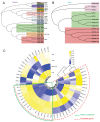Profiles of Metabolic Genes in Uncaria rhynchophylla and Characterization of the Critical Enzyme Involved in the Biosynthesis of Bioactive Compounds-(iso)Rhynchophylline
- PMID: 36551218
- PMCID: PMC9775700
- DOI: 10.3390/biom12121790
Profiles of Metabolic Genes in Uncaria rhynchophylla and Characterization of the Critical Enzyme Involved in the Biosynthesis of Bioactive Compounds-(iso)Rhynchophylline
Abstract
Rhynchophylline (RIN) and isorhynchophylline (IRN), two of the representative types of indole alkaloids, showed the unique spiroindole structures produced in Uncaria rhynchophylla. As the bioactive constituent of U. rhynchophylla, IRN has recently drawn extensive attention toward antihypertensive and neuroprotective activities. Despite their medicinal importance and unique chemical structure, the biosynthetic pathways of plant spiroindole alkaloids are still largely unknown. In this study, we used U. rhynchophylla, extensively used in traditional Chinese medicine (TCM), a widely cultivated plant of the Uncaria genus, to investigate the biosynthetic genes and characterize the functional enzymes in the spiroindole alkaloids. We aim to use the transcriptome platform to analyse the tissue-specific gene expression in spiroindole alkaloids-producing tissues, including root, bud, stem bark and leaf. The critical genes involved in the biosynthesis of precursors and scaffold formation of spiroindole alkaloids were discovered and characterized. The datasets from this work provide an essential resource for further investigating metabolic pathways in U. rhynchophylla and facilitate novel functional enzyme characterization and a good biopharming approach to spiroindole alkaloids.
Keywords: Uncaria rhynchophylla; biosynthetic pathway; rhynchophylline and isorhynchophylline; spiroindole alkaloids; transcriptome.
Conflict of interest statement
The authors declare that they have no conflict of interest.
Figures









Similar articles
-
De novo transcriptome sequencing and digital gene expression analysis predict biosynthetic pathway of rhynchophylline and isorhynchophylline from Uncaria rhynchophylla, a non-model plant with potent anti-alzheimer's properties.BMC Genomics. 2014 Aug 12;15(1):676. doi: 10.1186/1471-2164-15-676. BMC Genomics. 2014. PMID: 25112168 Free PMC article.
-
Transcriptome revealing the dual regulatory mechanism of ethylene on the rhynchophylline and isorhynchophylline in Uncaria rhynchophylla.J Plant Res. 2022 May;135(3):485-500. doi: 10.1007/s10265-022-01387-8. Epub 2022 Apr 5. J Plant Res. 2022. PMID: 35380307
-
Stereoselective in vitro metabolism of rhynchophylline and isorhynchophylline epimers of Uncaria rhynchophylla in rat liver microsomes.Xenobiotica. 2018 Oct;48(10):990-998. doi: 10.1080/00498254.2017.1390627. Epub 2017 Nov 10. Xenobiotica. 2018. PMID: 28990840
-
Pharmacological actions of Uncaria alkaloids, rhynchophylline and isorhynchophylline.Acta Pharmacol Sin. 2003 Feb;24(2):97-101. Acta Pharmacol Sin. 2003. PMID: 12546715 Review.
-
The beneficial pharmacological effects of Uncaria rhynchophylla in neurodegenerative diseases: focus on alkaloids.Front Pharmacol. 2024 Jul 31;15:1436481. doi: 10.3389/fphar.2024.1436481. eCollection 2024. Front Pharmacol. 2024. PMID: 39170707 Free PMC article. Review.
Cited by
-
A sterile plant culture system of Uncaria rhynchophylla as a biosynthetic model of monoterpenoid indole alkaloids.Plant Biotechnol (Tokyo). 2025 Jun 25;42(2):145-154. doi: 10.5511/plantbiotechnology.25.0218a. Plant Biotechnol (Tokyo). 2025. PMID: 40636431 Free PMC article.
-
Astrocytes from lamina cribrosa are involved in the autoregulatory function of optic nerve head vessels in vitro.Front Mol Biosci. 2025 Aug 13;12:1636882. doi: 10.3389/fmolb.2025.1636882. eCollection 2025. Front Mol Biosci. 2025. PMID: 40880987 Free PMC article.
-
Natural compounds from botanical drugs targeting mTOR signaling pathway as promising therapeutics for atherosclerosis: A review.Front Pharmacol. 2023 Jan 20;14:1083875. doi: 10.3389/fphar.2023.1083875. eCollection 2023. Front Pharmacol. 2023. PMID: 36744254 Free PMC article. Review.
References
Publication types
MeSH terms
Substances
Supplementary concepts
Grants and funding
LinkOut - more resources
Full Text Sources
Research Materials

